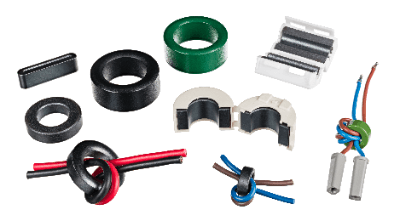What Is an EMC Countermeasure Component?

EMC (Electromagnetic Compatibility) countermeasure component devices are electronic components used for noise suppression in electrical equipment that handle signals. They’re essentially used to electronically separate a desired signal from noise. Once separated, the signal can be processed and manipulated. However, this signal-noise separation is not something that can be guaranteed if the electronic wave has been “contaminated” by unwanted signal dissonance.
Electromagnetic compatibility design has become something of a major issue Since all electronic components have the potential to leak unwanted electromagnetic field noise, no matter how well-designed they might be. Compatibility refers to unwanted electrical noise (emissions) that is emitted and propagated by an electronic device without causing any significant electromagnetic disturbance to other objects in the environment. In addition, it can further be described as the ability to function in a given electromagnetic environment with low susceptibility to interference (immunity).
Emissions are technically referred to as EMI (electromagnetic interference) and immunity as EMS (electromagnetic susceptibility). A variety of electronic components has been developed to address these issues. Here, several exotic solutions to neutralize high and low-frequency noise types are utilized. Ranging from inductor coils to capacitor filtering, several highly effective countermeasures are listed as follows.
Uses of EMC Countermeasure Components
EMCs are surrounded by many electronic devices, each of which inevitably experiences the impact of noisy electromagnetic signals and waves. If EMC countermeasure components are not properly taken, malfunctioning, switching without permission, or interference with communications might occur.
EMC countermeasure components are especially used in communication devices such as computers, mobile devices, smartphones, many home appliances, inverters, and other devices that perform actions involving signal conversion. However, as frequency bands change, more capable solutions are being explored.
EMC has its standards depending on the equipment used. For example, emissions from electric lighting, emissions from communications systems, emissions from multimedia equipment, immunity of multimedia equipment, medical electrical equipment, ships, automobiles, etc.
Principle of EMC Countermeasure Components
EMC countermeasure components can be roughly divided into three categories.
1. Frequency Separation
It functions as a filter by incorporating coils, beads, and resistors in series with the signal input and capacitors in parallel. An AC power line filter that combines a capacitor and a common mode filter is also used. If the expected noisy components are on the high-frequency side, an LPF (low pass filter) effectively cuts them.
2. Mode Separation
Either the common mode or normal mode can be effectively separated. The common mode describes a situation whereby the signal is sent in the same direction to the paired lines, while the normal (differential) mode describes a situation whereby the signal is sent in a different direction. In most cases, the common mode is an unwanted component, so components are used to attenuate it. For example, a CMF (common mode filter), ferrite core, or transmission transformer is placed in parallel with the signal.
3. Amplitude Separation
Noise can appear as a sudden phenomenon. Varistors and Zener diodes are incorporated in parallel to prevent transient changes in voltage, especially due to electrostatic effects such as noise. These are elements, whose resistance value changes, depending on the voltage.
Other Information related to EMC Countermeasure Components
1. EMC Design
EMC design has two main purposes. The first purpose is to reduce the noise output level (commonly called emissions) emitted by electronic equipment concerning electromagnetic noise, or EMC, which is called the electromagnetic compatibility of electronic equipment. The second purpose is to reduce EMI noise, the noise output level (commonly called emissions) emitted by electronic equipment.
The second is a noise tolerance design for EMS (commonly called immunity), which is the level of noise that an electronic device can withstand without malfunctioning even if it accepts noise. EMC design ensures that both of these circuit architecture aspects of the electronic equipment are sufficiently satisfied with the various standards, laws, and regulations for the electrical products in which the equipment is installed.
The actual EMC design includes: EMI filters, consisting of X capacitors and line filters to reduce normal line noise between power lines; ground capacitors (commonly known as Y capacitors) to reduce common ground noise; ferrite cores, ferrite beads, and common mode choke coils; In addition, ferrite cores, ferrite beads, common mode choke coils, electromagnetic wave absorbing sheets, and varistors and surge absorbers that clamp and remove external noise voltages such as lightning are used in many electronic devices.
2. Lightning Surge Countermeasure Components
Lightning surge countermeasure components are used to prevent electronic equipment from malfunctioning or breaking due to lightning. Normally, the electromagnetic compatibility (EMC) of electronic equipment, or the amount of electromagnetic noise emitted and the immunity to electromagnetic noise are determined by the EMC standards for each device in which the electronic equipment is installed.
Among the above-mentioned electromagnetic noise emission and immunity standards, lightning surge countermeasure components are mounted to increase immunity to EMS standards, commonly known as immunity to noise, and especially to lightning surge tests.
The usage of surge absorbers, such as varistors and surge arresters, is to be connected to the ground in combination with a grounding capacitor, etc., in an electric circuit. Their role is to release high-energy noise, including lightning coming from outside, to the ground (earth), thereby protecting electronic equipment from high-voltage damage. They play an important role in protecting electronic equipment from dangerous high-voltage charges and destruction by allowing lightning and other high-energy noise from outside to escape to the ground (earth).